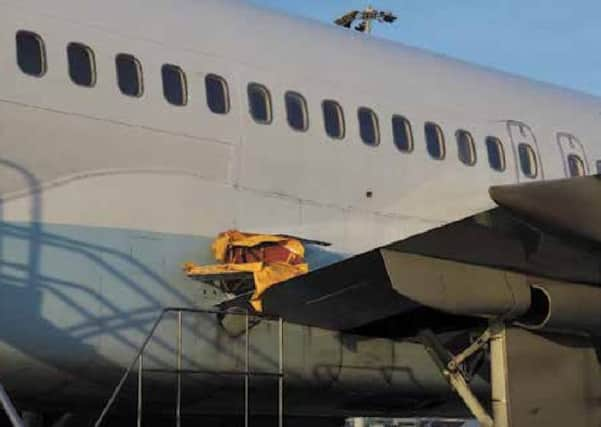Investigation report: Boeing 757 escape slide falls off during flight
This article contains affiliate links. We may earn a small commission on items purchased through this article, but that does not affect our editorial judgement.


The Boeing 757-300 was making an unscheduled return to Gatwick after a problem during takeoff.
A report by the Air Accident Investigation Branch (AAIB), published yesterday (Thursday August 13), said the incident happened aboard a Thomas Cook flight from Gatwick to Egypt on October 31 last year.
Advertisement
Hide AdAdvertisement
Hide AdSeveral minor issues are thought to have combined to loosen the slide release mechanism as the plane was taking off.
The plane was on the ground, travelling at about 70 knots (80.6 mph) when the cockpit instruments showed that the right over-wing escape slide container was not secure.
With no sign that the slide had actually come loose, the crew continued with their takeoff - as recommended by the Boeing quick reference handbook. However, after consulting their airline, they decided to return to Gatwick.
The pilot circled around for 40 minutes, with landing gear, flaps and airbrakes deployed to burn off excess fuel and get the plane down to a normal landing weight before taking it back to Gatwick.
Advertisement
Hide AdAdvertisement
Hide AdAs the plane descended to 3,000 ft, some of the cabin crew and passengers heard a number of bangs or felt the airframe shuddering. Two passengers reported seeing a white object falling from the right hand side of the aircraft.
It was later discovered that the object was the emergency slide, which had struck the body of the plane and one window before it fell.
On final approach, the pilot noticed that the autopilot seemed to be having trouble keeping the wings level.
He switched off the autopilot and took control. Although he could control the aircraft, he reported that it needed a ‘significant amount of left aileron’ to stop the plane rolling to the right.
Advertisement
Hide AdAdvertisement
Hide AdThis issue has been noticed before in cases where the slide carrier has opened in flight. The quick reference handbook recommends reduced flap settings to manage the problem while coming in to land, but only in cases where the slide has come loose but is still attached.
Boeing have now been advised to update the handbook to extend this advice to any 757-300 with a wing slide alert warning showing.
The plane landed safely. The slide itself landed in a tree, and was later recovered by the investigators.
Investigators discovered that a crank handle which controls the panel latches had moved to the release position.
Advertisement
Hide AdAdvertisement
Hide AdThe report said it was likely that someone had accidentally moved the handle slightly out of position, so that a slight additional factor could move it the rest of the way.
The AAIB found that a component missing from one of the flaps, and another that was loose, would have caused increased vibration on the plane.
“It is possible that the flap system vibration and resonance resulted in a gradual movement upwards of the crank handle over a period of time to the point whereby it allowed the slide carrier and panel to open with its locking devices in the released condition,” it said.
“Once open, it was in the air flow with the slide itself now no longer restrained within its pack. Thus it eventually unravelled in the slipstream flailing about against the fuselage until its attachment material failed allowing it to detach and fall to the ground.”
Advertisement
Hide AdAdvertisement
Hide AdSafety improvements, which were already being brought in when the incident happened, include alignment markings on the panel, which will make it easy to spot if the crank handle is slightly out of position.
During the investigation, it emerged that airlines and airport fire crews do not use a universal system to identify the various exits from a plane.
This could cause a serious problem during an emergency evacuation if, for example, fire crews needed to warn cabin staff not to use a particular exit.
The AAIB has now recommended that the European Aviation Safety Agency and other air safety regulators should bring in a standardised system.
Advertisement
Hide AdAdvertisement
Hide AdDon’t miss out on all the latest breaking news where you live.
Here are four ways you can be sure you’ll be amongst the first to know what’s going on.
1) Make our website your homepage at www.crawleyobserver.co.uk
2) Like our Facebook page at www.facebook.com/crawleyobserver
3) Follow us on Twitter @Crawley_Obby
Advertisement
Hide AdAdvertisement
Hide Ad4) Register with us by clicking on ‘sign in’ (top right corner). You can then receive our daily newsletter AND add your point of view to stories that you read here.
And do share with your family and friends - so they don’t miss out!
The Crawley Observer - always the first with your local news.
Be part of it.